
The 1897 VFL season was the inaugural season of the Victorian Football League (VFL), the highest-level senior Australian rules football competition in Victoria. The season ran from 8 May to 4 September, comprising a 14-round home-and-away season followed by a three-week finals series featuring the top four clubs. Eight Victorian Football Association (VFA) clubs – Carlton, Collingwood, Essendon, Fitzroy, Geelong, Melbourne, South Melbourne and St Kilda – featured in the inaugural season after seceding from the VFA in 1896.

The 1898 VFL season was the second season of the Victorian Football League (VFL), the highest-level senior Australian rules football competition in Victoria. The season featured eight clubs and ran from 14 May to 24 September, comprising a 14-round home-and-away season followed by a finals series featuring all eight clubs.

The 1899 VFL season was the third season of the Victorian Football League (VFL), the highest-level senior Australian rules football competition in Victoria. The season featured eight clubs and ran from 13 May to 16 September, comprising a 14-round home-and-away season followed by a finals series featuring all eight clubs.
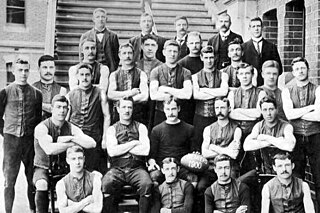
The 1900 VFL season was the fourth season of the Victorian Football League (VFL), the highest-level senior Australian rules football competition in Victoria. The season featured eight clubs and ran from 5 May to 22 September, comprising a 14-round home-and-away season followed by a finals series featuring all eight clubs.

The 1901 VFL season was the fifth season of the Victorian Football League (VFL), the highest-level senior Australian rules football competition in Victoria. The season featured eight clubs and ran from 4 May to 7 September, comprising a 17-round home-and-away season followed by a two-week finals series featuring the top four clubs.

The 1903 VFL season was the seventh season of the Victorian Football League (VFL), the highest-level senior Australian rules football competition in Victoria. The season featured eight clubs and ran from 2 May to 12 September, comprising a 17-round home-and-away season followed by a two-week finals series featuring the top four clubs.

The 1905 VFL season was the ninth season of the Victorian Football League (VFL), the highest-level senior Australian rules football competition in Victoria. The season featured eight clubs and ran from 6 May to 30 September, comprising a 17-match home-and-away season followed by a three-week finals series featuring the top four clubs.

The 1907 VFL season was the eleventh season of the Victorian Football League (VFL), the highest-level senior Australian rules football competition in Victoria. The season featured eight clubs and ran from 27 April to 21 September, comprising a 17-match home-and-away season followed by a three-week finals series featuring the top four clubs.
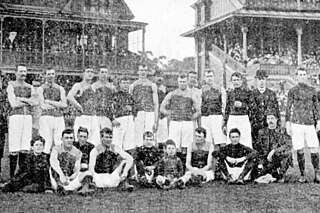
The 1908 VFL season was the twelfth season of the Victorian Football League (VFL), the highest-level senior Australian rules football competition in Victoria. The season featured ten clubs and ran from 2 May to 26 September, comprising an 18-match home-and-away season followed by a three-week finals series featuring the top four clubs. Victorian Football Association (VFA) club Richmond and Metropolitan Junior Football Association (MJFA) club University featured for the first time in 1908.
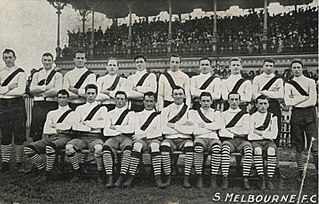
The 1909 VFL season was the 13th season of the Victorian Football League (VFL), the highest-level senior Australian rules football competition in Victoria. The season featured ten clubs and ran from 1 May to 2 October, comprising an 18-match home-and-away season followed by a four-week finals series featuring the top four clubs.

The 1910 VFL season was the 14th season of the Victorian Football League (VFL), the highest-level senior Australian rules football competition in Victoria. The season featured ten clubs and ran from 30 April to 1 October, comprising an 18-match home-and-away season followed by a four-week finals series featuring the top four clubs.
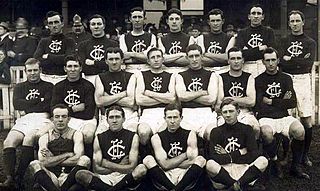
The 1914 VFL season was the 18th season of the Victorian Football League (VFL), the highest-level senior Australian rules football competition in Victoria. The season featured ten clubs and ran from 25 April to 26 September, comprising an 18-match home-and-away season followed by a four-week finals series featuring the top four clubs. It was the last season to feature University, which withdrew from the VFL after seven seasons after its strict policy of amateurism when player payments were becoming common, and its players focusing primarily on their studies, meant that the club could not remain competitive or viable in the league.

The 1915 VFL season was the 19th season of the Victorian Football League (VFL), the highest-level senior Australian rules football competition in Victoria. The season featured nine clubs and ran from 24 April to 18 September, comprising a 16-match home-and-away season followed by a four-week finals series featuring the top four clubs.

The 1916 VFL season was the 20th season of the Victorian Football League (VFL), the highest-level senior Australian rules football competition in Victoria. Played during the peak of World War I, the season was the shortest in the league's history and featured the fewest clubs, with only four clubs – Carlton, Collingwood, Fitzroy and Richmond – featuring in 1916. The season ran from 6 May to 2 September, comprising a twelve-match home-and-away season followed by a four-week finals series featuring all four clubs.
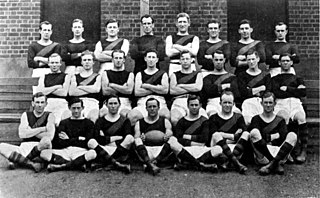
The 1920 VFL season was the 24th season of the Victorian Football League (VFL), the highest-level senior Australian rules football competition in Victoria. The season featured nine clubs and ran from 1 May to 2 October, comprising a 16-match home-and-away season followed by a four-week finals series featuring the top four clubs.
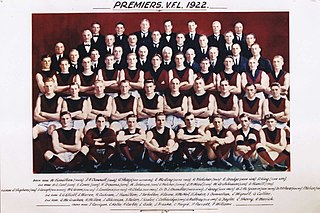
The 1922 VFL season was the 26th season of the Victorian Football League (VFL), the highest level senior Australian rules football competition in Victoria. The season featured nine clubs, ran from 6 May until 14 October, and comprised a 16-game home-and-away season followed by a finals series featuring the top four clubs.
The 1963 VFL season was the 67th season of the Victorian Football League (VFL), the highest level senior Australian rules football competition in Victoria. The season featured twelve clubs, ran from 20 April until 5 October, and comprised an 18-game home-and-away season followed by a finals series featuring the top four clubs.

The 1932 VFL season was the 36th season of the Victorian Football League (VFL), the highest level senior Australian rules football competition in Victoria. The season featured twelve clubs, ran from 30 April until 1 October, and comprised an 18-game home-and-away season followed by a finals series featuring the top four clubs.

The 1937 VFL season was the 41st season of the Victorian Football League (VFL), the highest level senior Australian rules football competition in Victoria. The season featured twelve clubs, ran from 24 April until 25 September, and comprised an 18-game home-and-away season followed by a finals series featuring the top four clubs.
The 1938 VFL season was the 42nd season of the Victorian Football League (VFL), the highest level senior Australian rules football competition in Victoria. The season featured twelve clubs, ran from 23 April until 24 September, and comprised an 18-game home-and-away season followed by a finals series featuring the top four clubs.


















